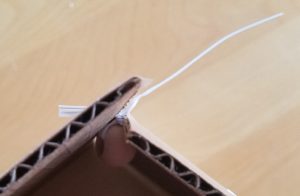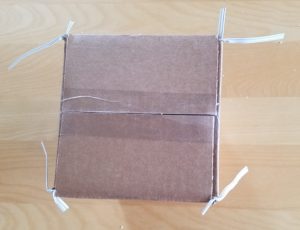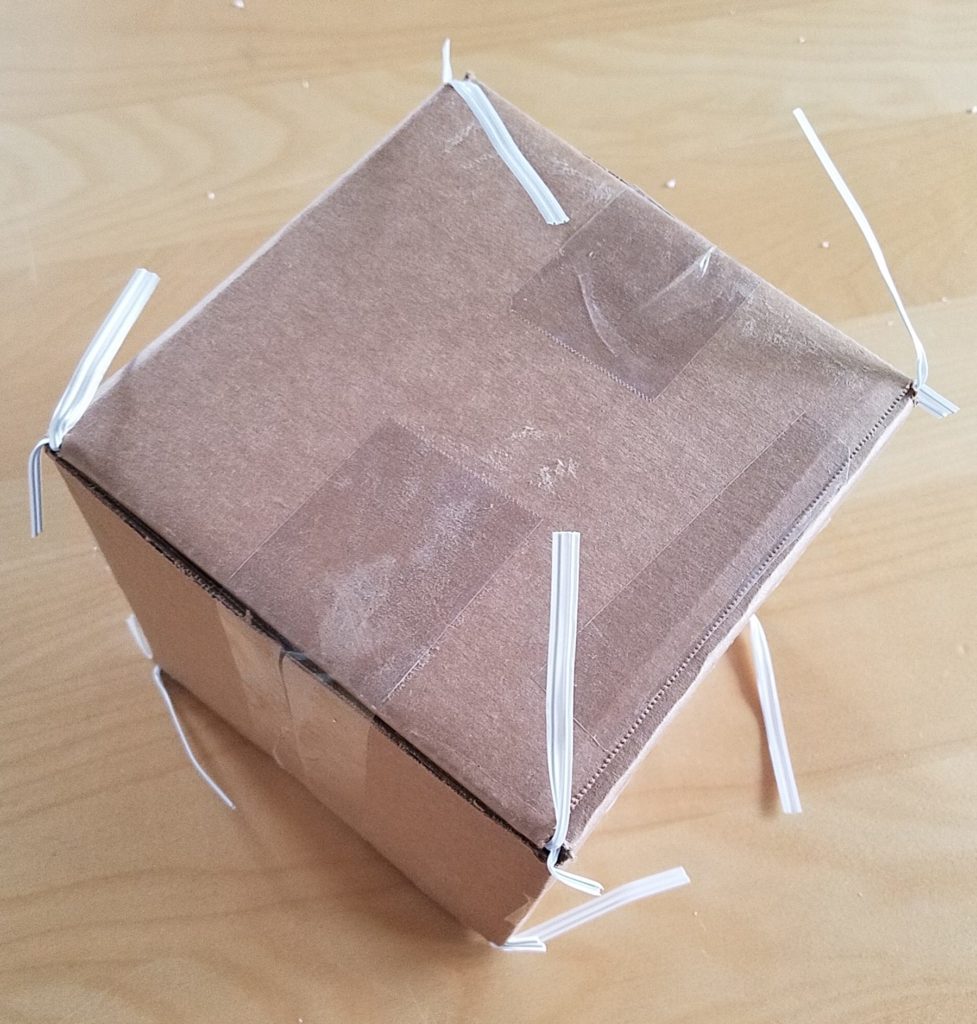Boxtets
As a result of the last couple of constructions, when Studio Infinity signed up to do a large-scale construction at the Golden Gate STEM Fair, I had the oct-tet lattice on my mind. And for a long time, I had wanted to exploit the connection between cubes and the oct-tet lattice. I just needed a way to connect cubes edge-to-edge.
Jürgen Richter-Gebert, founder of the ix-quadrat mathematics museum in Munich, Germany, suggested I could adapt the hinges he uses for making variable-angle kaleidoscopes. These hinges work extremely well, but they require a strap that at the joint changes which side of the strap is fastened to the boxes. This could probably be done by arranging the hooks and loops of double-sided velcro straps carefully, but I was afraid that the attachment would be too complex for a large-scale construction.
In another vein, I did a small construction connecting cubes vertex-to-vertex while I was the author of Math Mondays at Make: Magazine online. That connection method, however, required working on the insides of boxes in place in the structure before closing them up, which was much too intricate to scale up.
But then I realized that with a good, tight, vertex-to-vertex attachment, you can simply connect pairs of adjacent vertices to each other to create a strong edge-to-edge connection (and you can even put cubes face to face and attach all four corners to connect them that way as well).
So, here’s the procedure for making a cube with a securely fastened twist tie protruding from each vertex, ready for twisting together however you like to make cube-based sculptures. Given how they can be used to create oct-tet truss structures, I like to call them boxtets.
| Materials (for one boxtet) |
|---|
| cubical cardboard box |
| 8 heavy-duty twist ties |
| 8 large beads |
| packing tape |
 |
Some notes on the materials: You can buy cubical boxes online in a variety of sizes very cheaply; I used 6″ Uline boxes, which are currently available in bulk for 33 cents apiece. There are also a variety of twist ties available; if you’re planning on re-using your components, make sure to get the most heavy duty ones you can; I ordered from supplyplaza.com. Six to eight inches long work well; I’d recommend longer if you’re doing a large construction, even though the long wires sticking out look a bit awkward at first. Longer wires are just easier to get a hold of and pull tightly, and large constructions require very tight connections. Finally, I recommend beads at least 15 mm in diameter, preferably a bit larger, as they are what keeps the twist-ties from pulling out of the corners of the boxes. You want to use large-hole beads to make it easier to feed the twist-ties through.
Here’s how to put a boxtet together. First, you need to attach the twist ties to the beads. Insert a twist tie into a bead so that one end protrudes about twice the length of the bead, then bend it back around and twist it to itself, making sure to (a) twist it tight against the surface of the bead and (b) leave a small “tail” extending from the twist as well as the main long section of twist tie. Here’s what you should get.
When you have eight done, it’s time to assemble the boxtet.
Basically, you are assembling the box as usual, except before sealing up one side, you slip a bead down the slit between the flaps as shown at right — note that both the long end and the short “tail” of the twist tie are on the outside of the box.
The purpose of the tail is to keep the bead/twist tie combination from sliding all the way into the box so that the twist tie is no longer accessible.
Make sure you have beads in all four slots (as on the left) and then tape it up normally, like so (one piece of tape should suffice, as there’s essentially nothing inside the boxes).
Insert beads in the other side of the box and tape that up too, and you have your first boxtet.
In the next post we’ll see what we can build with them.
Update: At the Golden Gate STEM Fair, some participant(s) figured out a better way to construct a Boxtet.






